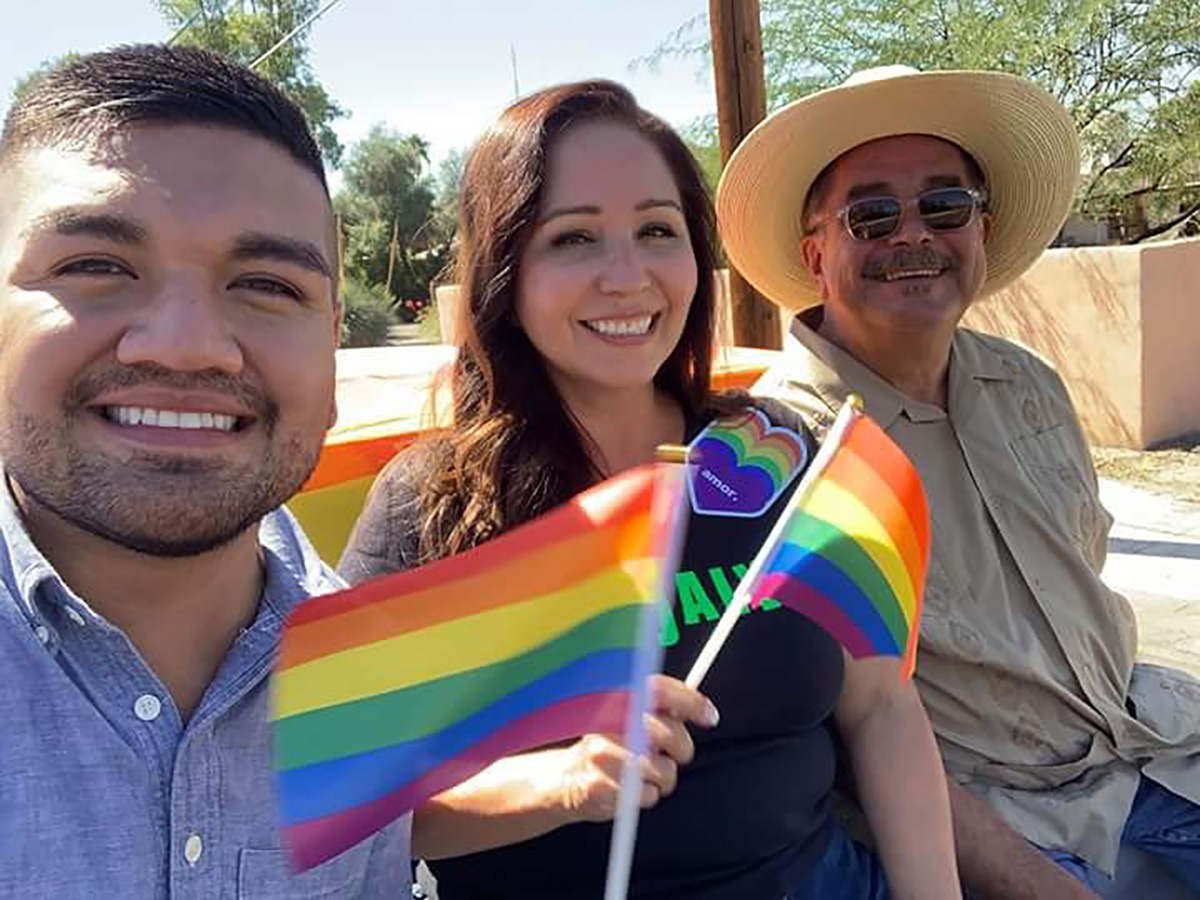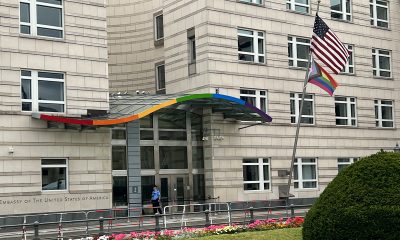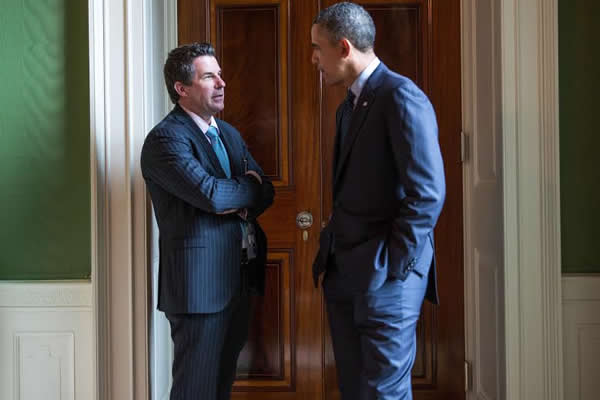Federal Government
Expert warns Trump’s drastic cuts to HHS will have far-reaching consequences
HRC’s HIV and LGBTQ health policy advocate shared his concerns with the Blade

Ten years ago, as the opioid epidemic ripped through communities across the United States, the recreational use of oxymorphone with contaminated needles led to an explosion of new HIV infections in southern Indiana’s Scott County.
In places like Austin, a city with about 4,000 residents, the rate of diagnoses quickly ballooned to levels seen in some of the hardest-hit nations of sub-Saharan Africa, more than 50 times higher than the national average.
Thankfully, by 2020, NPR reported that the area was rebounding from what was the most devastating drug-fueled HIV epidemic that rural America had ever experienced, with three-quarters of patients managing the disease so well with antiretroviral therapies that their viral loads were undetectable.
Five years after officials called a public health emergency over the outbreak in Scott County, Austin had opened new addiction treatment centers, support groups, and syringe exchanges.
Initially, Indiana’s response was sluggish. The state’s governor at the time, Mike Pence, opposed clean needle exchanges for 29 days before ultimately signing an executive order allowing for a state-supervised program.
The administration in which he would go on to serve as vice president, however, launched an ambitious initiative designed around the objective of ending the HIV epidemic in the U.S. by the end of the decade, using proven public health strategies including syringe exchanges.
NPR further noted “the administration’s HIV goals were championed” by Pence along with Trump’s U.S. Surgeon General, Jerome Adamsthe, who was Indiana’s health commissioner during the outbreak in Austin.
Still, the news service warned, the Centers for Disease Control and Prevention determined that 220 U.S. counties were vulnerable to outbreaks of HIV and other blood borne infectious diseases like hepatitis C.
“When you have these outbreaks, they affect other states and counties. It’s a domino effect,” Dr. Rupa Patel, an HIV prevention researcher at Washington University in St. Louis, told NPR. “We have to learn from them. Once you fall behind, you can’t catch up.”
Trump’s approach to public health, including efforts to prevent, detect, mitigate, and treat outbreaks of infectious diseases, looks radically different in his second term.
‘I don’t know why they hate public health so much’
The Washington Blade spoke with Matthew Rose, senior public policy advocate for the Human Rights Campaign, during a recent interview about the the administration’s dramatic cuts and mass layoffs that will totally reshape the way America’s health agencies are run under Trump’s secretary of the U.S. Department of Health and Human Services, Robert F. Kennedy, Jr.
“They’re dismantling all the things around” the first Trump administration’s Ending the HIV Epidemic in the U.S. effort, he said, eliminating key positions and offices within America’s health agencies that support this effort, including by tracking progress toward — or movement away from — the 2030 goalposts.
Rose said there is no evidence to suggest the initiatives combatting HIV that were begun when Trump was in office the first time were ineffective, either in terms of whether their long term cost-savings justified the investment of government resources to administer them or with respect to data showing measurable progress toward ending the epidemic within the decade.
Therefore and in the absence of an alternative explanation,, Rose said he is left with the impression that the Trump-Vance administration does not care about Americans’ public health, especially when it comes to efforts focused on disfavored populations, such as programs supporting access to PrEP to reduce the risk of HIV transmission through sex.
The outbreak in Scott County “can happen over and over again, if we don’t have CDC surveillance,” he warned. “We’re still having a fentanyl crisis in the country that we don’t seem to really want to deal with, but you end up with outbreaks that bloom and bloom very quick and very fast.”
Rose added, “The really crazy thing is that they got rid of disease intervention and branch and response,” referring to the CDC’s National Center for HIV, Viral Hepatitis, STD, and Tuberculosis Prevention, specifically its Division of HIV Prevention, and the various branches within that division that are responsible for different aspects of HIV prevention, care, and research. They include HIV Research, Behavioral and Clinical Surveillance, and Detection and Response.
“These are literally the disease detectives that chase down outbreaks,” Rose added. “When there’s a syphilis outbreak in an area, when COVID came along and we had to trace COVID outbreaks, like, those folks are the folks who do this.”
If (or perhaps when) communities experience an outbreak, “We wouldn’t truly know what’s going on until probably 10 years later, when those folks’ CD4 counts finally crash to an AIDS diagnosis level,” he said, at which point “they’re very, very sick.”
“They’ll start looking like we haven’t seen people look since probably 30, 40 years ago,” Rose said, a time well before the advent of highly effective medicines that from the perspective of many patients turned HIV from a death sentence to a manageable disease.
Additionally, “every person that we lose to follow up and care, if they don’t know their status, that’s where the majority of new diagnoses come from,” he said, noting that without the CDC’s work “bringing people back into care,” there is “no way of tracking that.” HIV positive people will continue to potentially transmit the disease to others as “their own health deteriorates at levels that it doesn’t need to deteriorate at,” Rose said, “so, we make it worse.”
Along with the breakthroughs in drug discovery that led to the introduction of highly efficacious and well tolerated antiretrovirals, the use of PrEP by those who are HIV-negative to drastically reduce the risk that they may contract the virus through sex has put the goal of eliminating the epidemic within reach.
“One of the things we learned from things like the PROUD study,” Rose said, referring to randomized placebo-controlled HIV trials conducted in the U.K. in 2016 “ is that if you can get to the highest impacted folks, the most vulnerable folks, for every one person you get on PrEP, you’re getting anywhere from 16 to 23 infections averted.”
Disparities in health outcomes are likely to worsen
Rose noted that “we’re finally starting to stabilize” the disproportionately high rate of new infections among gay and bisexual Black men who have sex with men thanks in large part to the federal government’s work by employees and divisions that were cut by Kennedy’s restructuring of HHS, initiatives like culturally competent public health messaging campaigns for vulnerable populations, addressing subjects like PrEP, other prevention methods, the importance of regular HIV/STI screenings, and the availability of treatments for HIV and other sexually transmitted infections.
There is no way of knowing if any intervention was effective in the absence of “surveillance units” to monitor the disease’s spread through communities and track mitigation efforts, he said, adding that the gutting of these positions comes as “Latin men have actually been catching [up to] Black men in terms of new diagnoses” while rates among Black and Latina trans women remain high.
Along with NCHHSTP’s Prevention Communication Branch, the health secretary’s near 20 percent cut to CDC staff also eliminated the center’s Division of Behavioral & Clinical Surveillance Branch, its Capacity Development Branch, its Quantitative Sciences Branch, and its HIV Research Branch.
As a result, Rose said “You’re going to see these populations get hit hardest again,” communities that have long suffered disproportionately from the HIV epidemic due to factors like racial or income-based disparities in access to testing and treatment.
Broadly, the CDC is distinguished from other agencies because the Atlanta-based agency’s remit is focused to a significant extent on the population level implementation of public health interventions, endeavoring to change health outcomes, he explained. With respect to PrEP, for example, once the drug was shown safe and effective in clinical research and the evidence supported its use as a critical tool in the federal government’s effort to stop the epidemic, the CDC is responsible for work like making sure at-risk populations who are disinclined to use condoms can stick with (or are sticking with) the medication regimen.
The administration’s cuts encompass programs on the research side as well as the implementation side, Rose said. For example, he pointed to the “decimation” of divisions within the National Institutes of Health’s National Institute of Allergy and Infectious Diseases, which conducts studies on HIV interventions from the preclinical basic science stage to double blind clinical trials such as those that led to the introduction of injectable PrEP, which can be administered once every other month after the first two doses.
In fact, Rose said he worked alongside Dr. Jeanne Marrazzo, who succeeded Dr. Anthony Fauci as head of NIAID, on the Microbicide Trials Network board looking for behaviorally congruent HIV prevention products for populations that might not wish to take an oral or injectable formulation of PrEP. He added that she is a “brilliant scientist” who helped him better understand the vaginal microbiome as well as the ways in which “we fall short on women’s health and women’s sexual health, and what that means in the context of HIV prevention.”
Together with other top officials like Dr. Jonathan (“Jono”) Mermin, who led the NCHHSTP, on or around April 1, Marrazzo was reportedly offered the chance to either be placed on administrative leave or relocate to Indian Health Service outposts in rural American Indian or Native Alaskan communities located in states like Montana, Oklahoma, and Alaska.
Infectious disease related risks and benefits of research extend beyond HIV
Rose stressed the risks presented by the administration’s decision to shutter divisions within NCHHSTP that were responsible for communications, education and behavioral studies around tuberculosis, especially provided how the disease is underdiscussed as a public health issue within U.S, borders — where rates of infection are elevated in certain communities, like unhoused and incarcerated populations, where queer folks are disproportionately represented.
The restructuring of NCHHSTP and NIAID also raises the chances of outbreaks of viral and bacterial infections spread through sex that these public health workers could have prevented or better contained, Rose said.
Instead, “for some reason, someone thought it was a good idea to get rid of labs at the Division of STIs,” at a time when “we’ve had increases in STIs for the last, like, six years,” including rising rates of congenital syphilis, “the one that kills babies” and increased diagnoses of the disease among gay men.
Additionally, Rose noted disparities in health outcomes for people living with hepatitis C are likely to worsen by the cessation of federal government initiatives to slow the spread of the disease — which co-infects one of every four patients with HIV and can be fatal if untreated because the virus can cause cirrhosis, cancer, failure of the liver — because direct acting antivirals that cure 95 percent of all cases are covered by most insurance plans only when the policyholder has already sustained severe liver damage.
Broadly, “the fact that we’re like, getting rid of the labs to test people means that we’re literally choosing to go backwards, stick our heads in the sand, and hope that no one has the ability to want to say anything,” he added.
Even populations who are less susceptible to infection with diseases like HIV stand to benefit from basic and clinical science research into the disease, Rose said.
He pointed to such examples as the drug discovery studies targeting a vaccine for HIV that ultimately led to the identification of combinations of antivirals that were capable of curing most cases of hepatitis C, the inclusion of participants with HIV in clinical trials that led to the introduction of Ebola vaccines, and breakthroughs in the biomedical understanding of aging that were reached through research into why patients with untreated HIV age more rapidly.
“We continuously find new scientific endeavors that are able to help the general population, but also able to help the LGBTQ population,” Rose said, as “the things that happen in the HIV space spill over to other places.”
“From the LGBTQ health perspective, and especially from the research side,” he said, “we have just, in the last decade, started to really think about what interventions those populations need — not just [with respect to] HIV, but [other health issues like] smoking, alcohol and substance use and abuse,” including “crystal meth, which is always the number two drug in most major cities.”
Likewise, as large swaths of America’s public health infrastructure are unraveled under the direction of the president and his health secretary, the dissolution of each position or each division should not be considered in isolation given (1) the interdisciplinary nature of the work in which these individuals and entities are engaged and (2) the administration’s efforts elsewhere to restrict access to healthcare, especially for disfavored populations like trans and gender-diverse communities.
“There’s first the attack on the research pipeline,” Rose said, such as the HIV Vaccine Trials Network’s identification of an urgent or unmet need (behaviorally congruent methods of HIV prevention for women) and its discovery of a new intervention through research and clinical trials (a ring worn inside the vagina that releases an antiretroviral drug to stop the virus from entering the body during sex).
“Then there’s the destruction of key health interventions,” he said. For example, “STI testing is a public health intervention. It keeps people healthy, and we’re able to reduce the amount of STI floating in populations” through regular testing and monitoring of new diagnoses. “Getting rid of programs that look at and support these [efforts] is really, really bad,” Rose said.
He noted that the administration has endeavored to restrict healthcare access along a variety of fronts, especially when it comes to transgender medicine for youth, Rose said, from working to pass regulations circumscribing the scope of the ACA’s coverage mandate to gutting the HHS Office of Civil Rights such that vulnerable populations have less recourse when they are denied access to care or experience unlawful discrimination in healthcare settings, and conditioning the government’s federal funding for providers and hospital systems on their agreement not to administer guideline directed, evidence based interventions for the treatment of gender dysphoria in youth.
“Last year, CDC documented that we had reduced new HIV infections by 6% and by 23% and 26% in counties that were in the Ending the Epidemic jurisdictions,” Rose said.
In the face of these challenges shortly into the president’s second term, he said, “we will stand up to a scientific rigorous process every time, because we’ve done it every time, and every time we’ve done it, the world has been better for it.”
Federal Government
HHS ‘peer-reviewed’ report calls gender-affirming care for trans youth dangerous
Advocates denounce document as ‘sham science’

The U.S. Department of Health and Human Services on Nov. 19 released what it called an updated “peer reviewed” version of an earlier report claiming scientific evidence shows that gender-affirming care or treatment for juveniles that attempts to change their gender is harmful and presents a danger to “vulnerable children.”
“The report, released through the Office of the Assistant Secretary of Health, finds that the harms from sex-rejecting procedures — including puberty blockers, cross-sex hormones, and surgical operations — are significant, long term, and too often ignored or inadequately tracked,” according to a statement released by HHS announcing the release of the report.
“The American Medical Association and the American Academy of Pediatrics peddled the lie that chemical and surgical sex-rejecting procedures could be good for children,” said HHS Secretary Robert F. Kennedy Jr. in the HHS statement, “They betrayed their oath to first do no harm, and their so-called ‘gender affirming care’ has inflicted lasting physical and psychological damage on vulnerable young people,” Kennedy says in the statement.
The national LGBTQ advocacy organizations Human Rights Campaign and GLAAD issued statements on the same day the HHS report was released, denouncing it as a sham based on fake science and politics.
HRC called the report “a politically motivated document filled with outright lies and misinformation.”
In its own statement released on the same day the HHS report was released, HRC said HHS’s so-called peer reviewed report is similar to an earlier HHS report released in May that had a “predetermined outcome dictated by grossly uninformed political actors that have deliberately mischaracterized health care for transgender youth despite the uniform, science backed conclusion of the American medical and mental health experts to the contrary.”
The HRC statement adds, “Trans people’s health care is delivered in age-appropriate, evidence-based ways, and decisions to provide care are made in consultation with doctors and parents, just like health care for all other people.”
In a separate statement, GLAAD CEO Sarah Kate Ellis called the HHS report a form of “discredited junk science.” She added the report makes claims that are “grossly misleading and in direct contrast to the recommendations of every leading health authority in the world … This report amounts to nothing more than forcing the same discredited idea of conversion therapy that ripped families apart and harmed gay, lesbian, and bisexual young people for decades.”
In its statement announcing the release of its report, HHS insists its own experts rather than those cited by its critics are the ones invoking true science.
“Before submitting its report for peer review, HHS commissioned the most comprehensive study to date of the scientific evidence and clinical practices surrounding the treatment of children and adolescents for ‘gender dysphoria,’” the statement continues. “The authors were drawn from disciplines and professional backgrounds spanning medicine, bioethics, psychology, and philosophy.”
In a concluding comment in the HHS statement, Assistant Secretary for Health Brian Christine says, “Our report is an urgent wake-up call to doctors and parents about the clear dangers of trying to turn girls into boys and vice versa.”

President Donald Trump on Wednesday signed a bill that reopens the federal government.
Six Democrats — U.S. Reps. Jared Golden (D-Maine), Marie Gluesenkamp Perez (D-Wash.), Adam Gray (D-Calif.), Don Davis (D-N.C.), Henry Cuellar (D-Texas), and Tom Suozzi (D-N.Y.) — voted for the funding bill that passed in the U.S. House of Representatives. Two Republicans — Thomas Massie (R-Ky.) and Greg Steube (R-Fla.) — opposed it.
The 43-day shutdown is over after eight Democratic senators gave in to Republicans’ push to roll back parts of the Affordable Care Act. According to CNBC, the average ACA recipient could see premiums more than double in 2026, and about one in 10 enrollees could lose a premium tax credit altogether.
These eight senators — U.S. Sens. Catherine Cortez Masto (D-Nev.), Dick Durbin (D-Ill.), John Fetterman (D-Pa.), Maggie Hassan (D-N.H.), Tim Kaine (D-Va.), Angus King (I-Maine), Jacky Rosen (D-Nev.), and Jeanne Shaheen (D-N.H.) — sided with Republicans to pass legislation reopening the government for a set number of days. They emphasized that their primary goal was to reopen the government, with discussions about ACA tax credits to continue afterward.
None of the senators who supported the deal are up for reelection.
King said on Sunday night that the Senate deal represents “a victory” because it gives Democrats “an opportunity” to extend ACA tax credits, now that Senate Republican leaders have agreed to hold a vote on the issue in December. (The House has not made any similar commitment.)
The government’s reopening also brought a win for Democrats’ other priorities: Arizona Congresswoman Adelita Grijalva was sworn in after a record-breaking delay in swearing in, eventually becoming the 218th signer of a discharge petition to release the Epstein files.
This story is being updated as more information becomes available.
Federal Government
41 days and counting: Arizona’s Adelita Grijalva says ‘this has gone way too far’
Representative Adelita Grijalva sits down with the Blade to discuss the Epstein files, transgender rights, and her fight to represent Arizona.

Adelita Grijalva, the recently elected representative from Arizona’s Seventh Congressional District, has already begun making history—without having stepped foot into the Capitol. Grijalva is now officially the longest-delayed member of the House to be sworn in—41 days and counting.
She was elected in a special election on Sept. 23 by a two-to-one margin over her Republican opponent, following the death of her father, Raúl Grijalva, who had represented the district from 2003 until early 2025. The district includes a large portion of Arizona’s southern border with Mexico.
Despite being elected more than 40 days ago, Grijalva has not been given the opportunity to begin her work representing Arizona in the House of Representatives.
Mike Johnson, the Speaker of the House and a representative from Louisiana, has offered several explanations for the delay in swearing in Grijalva—ranging from waiting until all votes were certified in the special election (despite not requiring Republicans who also won special elections to wait) to claiming the House needed to return from recess (despite precedent showing new members are typically sworn in the day after their election, regardless of whether the House is in session). Most recently, Johnson has said Grijalva will not be sworn in until the government reopens.
The Washington Blade sat down with Grijalva to discuss the historic delay in her swearing-in, the importance of protecting transgender rights, book bans, environmental issues, and much more.
While Speaker Johnson has given many explanations for the delay, Grijalva said one stands out above the rest—the Epstein files. She ran on a promise to sign a discharge petition to force a vote for the release of the complete Epstein files, a hypothesized document containing the names of high-profile clients to whom the American financier and convicted child sex offender Jeffrey Epstein trafficked young girls. Her signature on the petition would be the 218th, the minimum number required to force a vote.
“I’ve now broken all the records for speaker obstruction. Nobody else has ever had to wait this long just to represent their constituents… I never received one communication directly from his office,” Grijalva said of Speaker Johnson’s lack of reasoning for the delay. “It seems to me they’re doing everything they can to stop the release of the Epstein files, and I just don’t know what else it could be.”
She added that Johnson’s obstruction isn’t just about her—it’s about the people she was elected to serve.
“We have 812,000 people here in Congressional District 7, and my problem is there’s so much we can’t do,” she said. “So when Speaker Johnson has little side comments to say about what I should and shouldn’t be doing, it’s like—why don’t you do your job so I can do mine?”
For Grijalva, the issue isn’t partisan—it’s about principle. “It shouldn’t matter my party. I won my election fairly and legally, and there’s no reason why my voters should be punished because the Speaker doesn’t like what I stand for,” she said.
She also pointed out the irony that her call for transparency on the Epstein files mirrors one made by Donald Trump himself during his presidential campaign.
“Trump ran on day one, ‘I’m going to release those files,’ and I think he got into office, saw what was in them, and said, ‘Maybe we wait on that,’” she explained. “That’s what I feel is happening now—they’re trying to delay and distract from something that’s going to make a lot of powerful people look bad.”
Still, Grijalva said not all Republicans support Johnson’s decision to keep her from being sworn in. “A couple Republicans have said, ‘Yeah, she should be sworn in. This is crazy.’ I appreciate that—it shouldn’t matter my party. I should be sworn in, period. I think some people on their side know this has gone way too far.”
As the government shutdown drags on, Grijalva said the consequences of congressional inaction are becoming increasingly dire for ordinary Americans.
“Who’s really suffering are the federal workers—people on federal grants, SNAP benefits—who don’t know when they’ll get their next paycheck or how they’ll feed their families,” she said. “These are real-life consequences while they play political games.”
Her frustration over the Epstein files remains steadfast. Grijalva said accountability and transparency must come before politics.
“I don’t care who’s implicated. I don’t care what party they are. If you committed a crime—if you raped children and women—you deserve legal consequences. Survivors deserve transparency and justice so they can begin healing.”
Beyond political accountability, Grijalva also emphasized the urgent need to address environmental degradation—a crisis that hits especially close to home.
“Trump doesn’t care about our environment. If there’s a dollar to be made, he’s going to do it, and he’s not thinking about the long-term consequences for people who actually have to live with the damage,” she said.
The Trump-Vance administration has rolled back a slew of Biden-era environmental policies, from pulling the U.S. out of the Paris Climate Accords to weakening pollution standards and expanding drilling for fossil fuels. For Grijalva, these choices have real, human consequences.
“My dad lived in a Superfund site and drank poisoned water for 15 years. Cancer is now part of our family because of that. These policies aren’t abstract—they hurt real people.”
Her father, the late Raúl Grijalva, passed away from lung cancer earlier this year. The Environmental Working Group estimates that between 100,000 and 122,000 cancer cases in the U.S. may stem from contaminated water—something Grijalva said her family understand all too well.
She also pointed out how allowing environmental destruction by repealing laws meant to protect natural resources threatens Arizona’s economy and identity.
“Arizona is an ecotourism hotspot—there are thousands of jobs tied to protecting our lands. When you destroy it, you can’t put it back together,” she said. “The mining laws are so old that we don’t even get any proceeds for years. It’s like someone digging in your backyard, taking your gold, and then telling you to buy it back later.”
“When people say environmental protection isn’t a priority, I just think of my dad and of our state,” she added. “You don’t gamble with people’s health for a quick profit.”
Shifting to social issues, Grijalva spoke at length about protecting transgender rights during a time when many—particularly on the right—continue to villainize the community.
“Trans rights are human rights. That’s it,” she said firmly. “When I say I’ll speak up for those who don’t feel they have a voice, I mean everybody—especially people who’ve been pushed to the margins.”
She didn’t shy away from calling out members of her own party who, in her view, haven’t done enough. “It’s disappointing that some Democrats are willing to stay silent as a whole community is being attacked,” she said. “Maybe they’ve never known what it’s like to be targeted, but once you have, you stand up for those who need more support.”
“I believe gender-affirming care is life-saving care,” she continued. “We have to push back against these anti-LGBTQ laws and fight for the Equality Act because the federal government has a responsibility to protect people, not erase them.”
“It’s not the government’s business who you love or who you are,” she added. “You should have the autonomy to be whoever you want to be—that is America.”
The congresswoman also spoke passionately about the growing movement to ban books and target libraries—something she called “deeply personal.”
“I’m not only the wife—I’m the daughter and sister of librarians,” Grijalva said with a laugh. “So if I’m not an advocate for our libraries, I’m in a lot of trouble. There should not be banned books. Those stories are a lifeline for students who don’t have support at home.”
She recalled a conversation that underscored her frustration with the movement. “A woman once showed me a book and said, ‘Do you think this should be available to children?’ I said, ‘Are the pictures anatomically inaccurate? Because if they’re correct, why do you care?’ We shouldn’t be policing truth or reality just because it makes some adults uncomfortable.”
Public service, for Grijalva, has always been personal. She was the youngest woman ever elected to the Tucson Unified School District Governing Board in 2002 and served in that role for 20 years—making her one of the longest-serving board members in history.
“I’ve been in elected office for 22 years,” she reflected. “People from high school tell me I’m the same person—and that’s what I want. You don’t let the environment change you; you change the environment.”
“I always have to look my kids in the eye at the end of the day,” she added. “If I have to explain a vote too much, then it’s wrong. That’s the standard I hold myself to.”
Even amid the uncertainty of her delayed swearing-in, Grijalva said she remains focused on the people she was elected to serve.
“The privilege of being able to speak for 812,000 people—it’s overwhelming, but it’s such an honor,” she said. “I’m excited to get sworn in and finally start doing the work my community sent me to do.”
-

 The White House4 days ago
The White House4 days agoTrump’s shocking East Wing amputation—and the painful fallout Americans won’t ignore
-

 District of Columbia4 days ago
District of Columbia4 days agoThird LGBTQ candidate running for Ward 1 D.C. Council seat
-

 Health3 days ago
Health3 days agoThe harsh truth about HIV phobia in gay dating
-

 Arts & Entertainment3 days ago
Arts & Entertainment3 days agoCynthia Erivo, Eva Victor, and ‘Blue Moon’ bring queer representation to Golden Globe film nominations


















